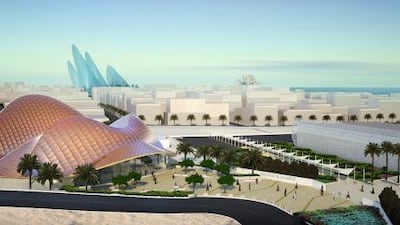The annual Abu Dhabi Art fair is moving home. When the fair kicks off in November, the manicured lawns and high-ceilinged ballrooms of the Emirates Palace hotel will be swapped for the in-construction cultural campus of Saadiyat Island.
Art: The National looks
Exhibitions, reviews, news, features and all things art
It’s quite a statement. Since Abu Dhabi first set up an art fair – as Art Paris-Abu Dhabi in 2007 – through to last year’s showing, which catered to 17,000 visitors, the city’s most famous hotel has been a key fixture in the fair’s image.
That is set to change this year. The 2011 event will take place on Saadiyat Island. The venues for the fair will be Manarat Al Saadiyat, the temporary exhibition hall on the island, which has already held several ambitious shows such as the recent Splendours of Mesopotamia, and, as was announced last week, the UAE Pavilion transplanted from the recent Shanghai World Expo. The pavilion was designed by Foster+Partners and held exhibits exploring the cultural history of the UAE during the Expo. For Abu Dhabi Art, the pavilion is being reconstructed pole-by-pole on Saadiyat (a feat in itself) and will play a pivotal role in the fair's programme of talks, workshops and satellite shindigs.
It’s refreshing to see that the capital’s art fair is looking to reposition itself. Moving out of the gilded exhibition halls of the Emirates Palace and on to an island that will one day be home to the Louvre and Guggenheim is a clear statement that this is not solely a transient, transactional space. Rather, the suggestion is that it is an equal engine in the cultural district’s emergence.
It’s no secret that many gallerists from the traditional art hubs of Paris, New York and London are drawn to the fair by the prospect that their artists might be snapped up by curators shaping the collections of the new museums. Putting the fair on the doorstep of these developments (both tipped for completion in the next two years) serves to emphasise that relationship.
Sceptics may cite the half-built character of the island: Saadiyat is still largely a weave of empty streets punctuated by construction sites and traffic cones, an unlikely location, both for infrastructure and the art world’s glitterati. “The whole of the UAE is a building site,” as Charlie Pocock, director of Meem Gallery in Dubai and a stalwart presence at the fair, points out.
“We have to accept that right now,” he says. “I think this new location is a lot better for the fair – there’s more flexibility and it is more realistic, as Emirates Palace is incredibly expensive.”
Pocock is effusive about the move, citing the success of previous exhibitions at the Manarat Al Saadiyat space as a sign of things to come.
“Saadiyat Island is a lot more accessible from Dubai,” he explains. “Bringing the Foster+Partners pavilion is a superb idea as well, because it allows the fair to identify itself. Abu Dhabi Art is there, in part, to introduce Emiratis to international art and it adds to the function of what Saadiyat Island is eventually going to be.”
Meem Gallery specialises in art from Iran and the Arab world. Pocock’s stable includes some of the key figures in this regional scene – including the Iraqi modern master Dia Al Azzawi and Parviz Tanavoli. At last year’s fair, the gallery launched a heavyweight monograph of Azzawi, accompanied by a selection of his sculptural works. This time around, Pocock explains, an 8x2.4m painting by the artist will form the centrepoint of Meem’s booth.
The gallery list for 2011 is now online. Returning after an absence last year is Dubai’s Gallery Isabelle van den Eynde, which looks after some of the foremost names in contemporary Iranian art. Similarly, the lineup seems markedly more diverse compared with the wealth of international big-hitters that typified the event last year. Although Gagosian, White Cube and Hauser & Wirth return, they’re joined by the likes of Rose Issa Projects, October Gallery and Lisson Gallery – newcomers to the event.
The capital’s fair was always going to want to have its own identity, particularly with Art Dubai firmly on the radar of those wanting to know more about the regional scene. Yet in previous years, a curious image for Abu Dhabi Art has been wrought: On one side, we’ve seen high-flying prices and galleries clamouring to get noticed by the new museums by bringing large works from ultra-famous artists. Unlikely figureheads such as the American artist Jeff Koons have led the charge.
On the flip side, a no-expenses-spared campaign of ambitious performances and events around the art fair is designed to ensure local relevance and academic weight.
The move to Saadiyat, a space with a far more public agenda than the private halls of a hotel, could be seen as phase two of that evolving project. If that’s the case, then the message seems to be that the event is ready to graduate now that the groundwork has been done.
Follow us on Twitter and keep up to date with the latest in arts and lifestyle news at twitter.com/LifeNationalUAE

